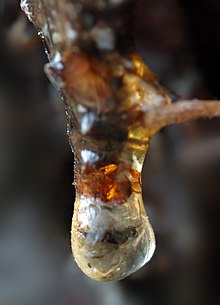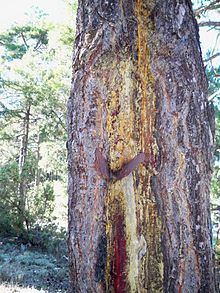Resin
The resin is an organic secretion produced by many plants, particularly coniferous trees. It serves as a natural defense coating against insects or pathogenic organisms. It is highly valued for its chemical properties and its associated uses, such as the production of varnishes, adhesives and food additives. It is also a common constituent of perfumes or incense. In many countries, including Spain, it is common to refer to the "resin" as "pine resin" since this conifer is its main source.
Definitions
There is no agreement on the name of the resin and its derivatives. In this article, the one accepted by the Academy of the Spanish Language will be used. When it may cause confusion, the most frequently used synonyms are included.
- Resin: is the solid substance or pasty consistency, insoluble in water, soluble in alcohol and in essential oils, and able to solidify in contact with the air, naturally obtained as a product that flows from several plants.
- Trementin: it is an almost liquid, sticky, odorferous and spicy juice, which flows from pines, bees, alerces and terebintos. It is mainly used as a solvent in the painting and varnish industry.
- Also known as Miera and sometimes like resin.
- Aguarrás: Trementin volatile oil, mainly used as a paint and varnish solvent.
- It is also known as Trementina or essence of trementin.
- Colony: Solid resin, product of the distillation of the trementine, used in pharmacy and for other uses.
- Sometimes the term is used resin to name this solid product.
- Pez (feminine): A substance of resinous, solid, lustrous, brittle and yellowish brown, which is obtained by pouring in cold water the residue that leaves the trementine when the water is removed.
- It's a more or less impurified colophony.
- Campeche Wax: natural adhesive created by the Melipona beecheii, American species of bee without aguijón that the Mayas called Xunán kab and that to make it mix the resin of the trees with mud and propoleos.
The term also includes synthetic substances with properties similar to natural resins. In this way, resins are divided into: natural resins and synthetic resins.
Natural resins
- Amber
- True resin
- Gomorresins
- Oleorresins
- We calm down.
- Lactorins
Synthetic resins
- Polyester
- Polyurethane
- Epoxy resin
- Acrylics
- Viniléster
- Composites
Composition
Resin is a complex mixture of terpenes, resin acids, fatty acids and other complex components: alcohols, esters... The proportion of each component is a function of the tree species and geographic origin. Typical values are:
- 60-75 % of resinic acids.
- 10-15 % of earthlings.
- 5-10 % of various substances and water.
By distillation at ambient pressure, it is possible to separate two fractions:
- 60 - 75% of Colofonia.
- 15 - 25 % of water and water.
Rosinmaker
The trade of resin tapper was very common among mountain towns for much of the last century. The resin was extracted from the extensive pine forests, which was sold at a good price in the market, since its use in the industry was very varied. New production techniques and new materials have relegated this trade to oblivion.
In Spain, the province of Segovia, because it is framed within the Tierra de Pinares region, has been the largest producer of resin. The town of Cuéllar stands out, whose high production allowed the supply of part of Castilla and Andalusia In 1958, the image of the Virgen del Henar, patron saint of the Community of Villa y Tierra de Cuéllar, was proclaimed patron saint of resin makers in Spain by the Supreme Pontiff Pío XII. Another important focus of production in the province It was the town of Coca. Both re-established industry in the area in the 21st century.
In Molinicos (Albacete) the resin industry extracted large quantities of this material from the extensive pine forests in the municipality. Even today we can see the footprint of this industry in the trunks of the pine trees.
Contenido relacionado
Aromatic compound
Natural Sciences
Calathea




